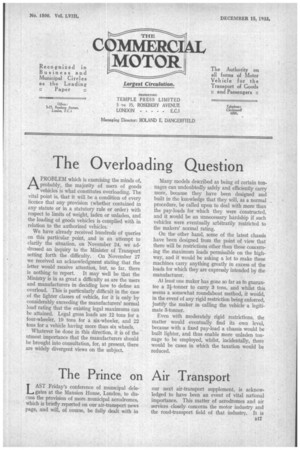The Overloading Question
Page 35

If you've noticed an error in this article please click here to report it so we can fix it.
APROBLEM which is exercising the minds of, probably, the majority of users of goods vehicles is what constitutes overloading. The vital point is, that it will be a condition of every licence that any provision (whether contained in any statute or in a statutory rule or order) with respect to limits of weight, laden or unladen, and the loading of goods vehicles is complied with in relation to the authorized vehicles.
We have already received hundreds of queries on this particular point, and in an attempt to clarify the situation, on November 24, we addressed an inquiry to the Minister of Transport setting forth the difficulty. On November 27 we received an acknowledgment stating that the letter would receive attention, but, so far, there is nothing to report. It may well be that the Ministry is in as great a difficulty as are the users and manufacturers in deciding how to define an overload. This is particularly difficult in the case of the lighter classes of vehicle, for it is only by considerably exceeding the manufacturers' normal load rating that the existing legal maximums can be attained. Legal gross loads are 12 tons for a four-wheeler, 19 tons for a six-wheeler, and 22 tons for a vehicle having more than six wheels.
Whatever be done in this direction, it is of the utmost importance that the manufacturers should he brought into consultation, for, at present, there are widely divergent views on the subject. Many models described as being of certain tonnages can undoubtedly safely and efficiently carry more, because they have been designed and built in the knowledge that they will, as a normal procedure, be called upon to deal with more than the pay-loads for which they were constructed, and it would be an unnecessary hardship if such vehicles were eventually arbitrarily restricted to the makers' normal rating.
On the other hand, some of the latest chassis have been designed from the point of view that there will be restrictions other than those concerning the maximum loads permissible on the highway, and it would be asking a lot to make these machines carry anything -greatly in excess of the loads for which they are expressly intended by the manufacturer.
At least one maker has gone so fax as to guarantee a 2i-tonner to carry 3 tons, and whilst this seems a somewhat roundabout method, it would, in the event of any rigid restriction being enforced, justify the maker in calling the vehicle a legitimate 3-tonner.
Even with moderately rigid restrictions, the matter would eventually find its own level, because with a fixed pay-load a chassis would be built lighter, and thus enable more unladen tonnage to be employed, whilst, incidentally, there would be cases in which the taxation would be reduced.




































































































